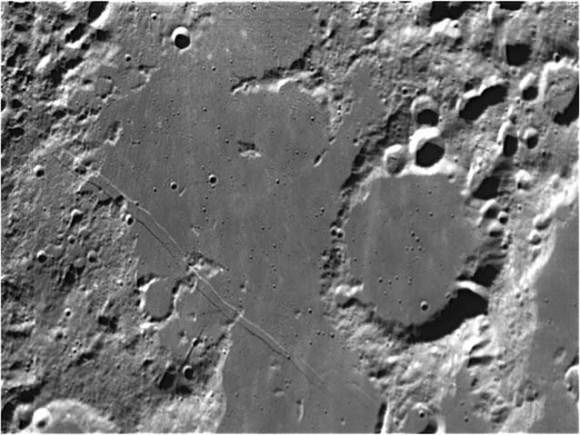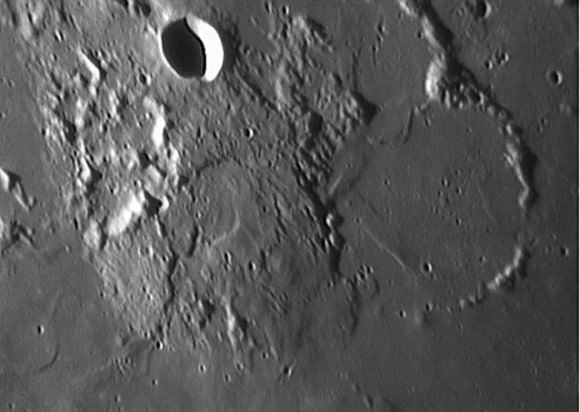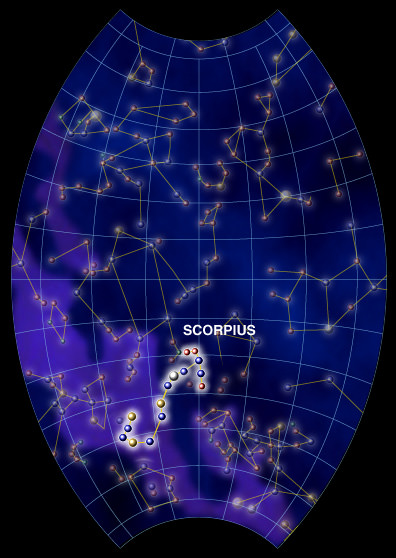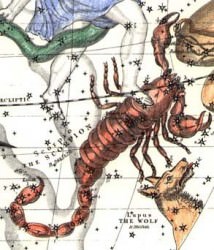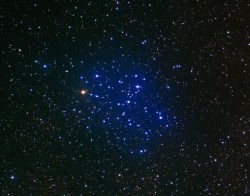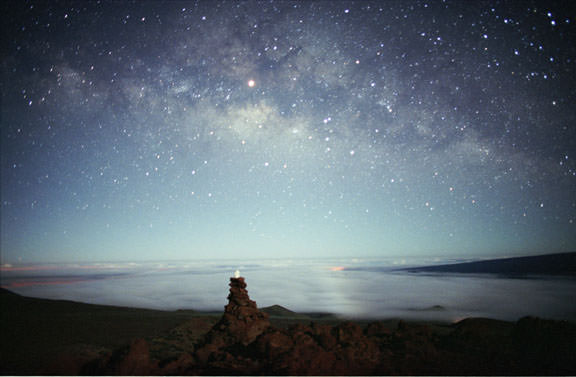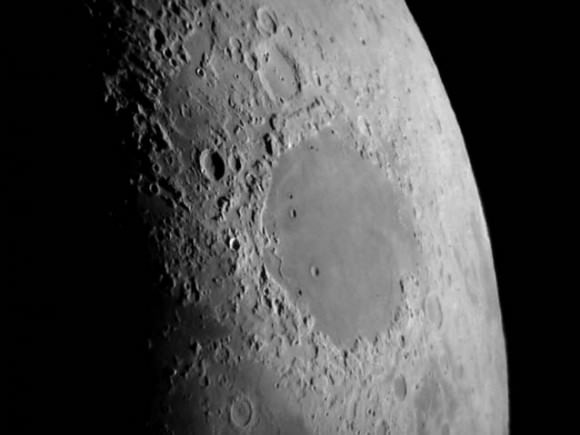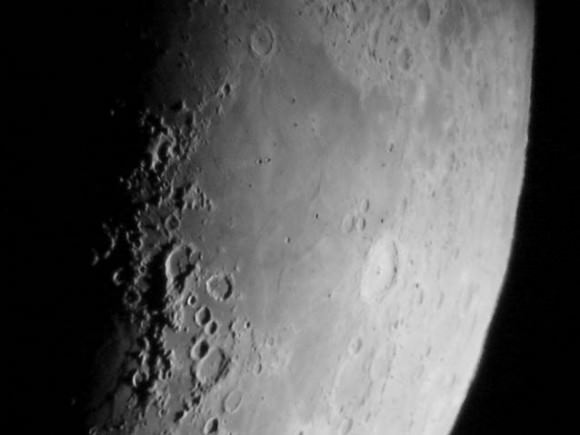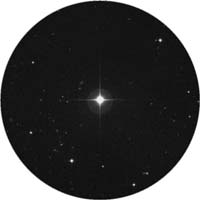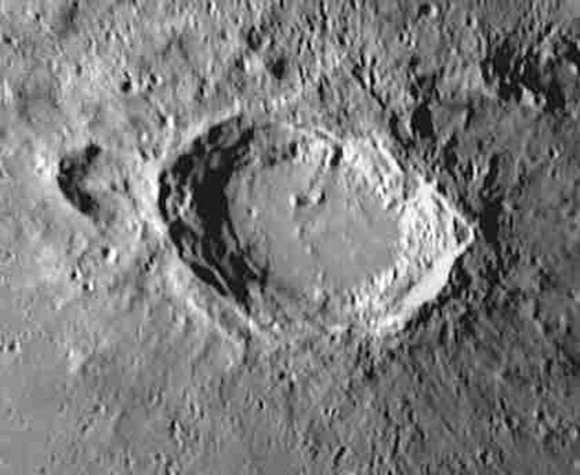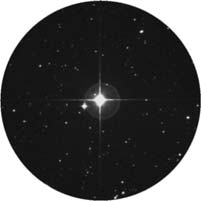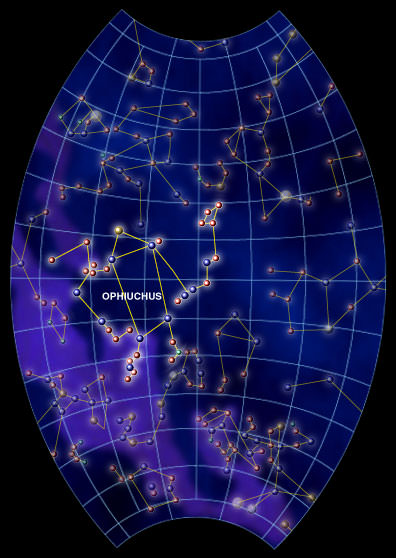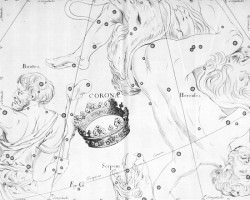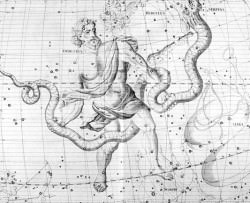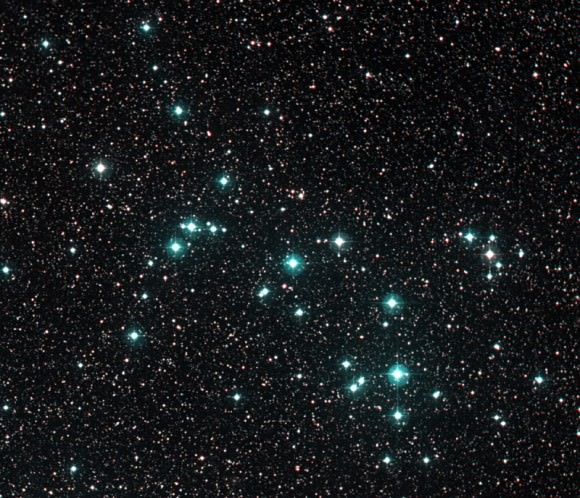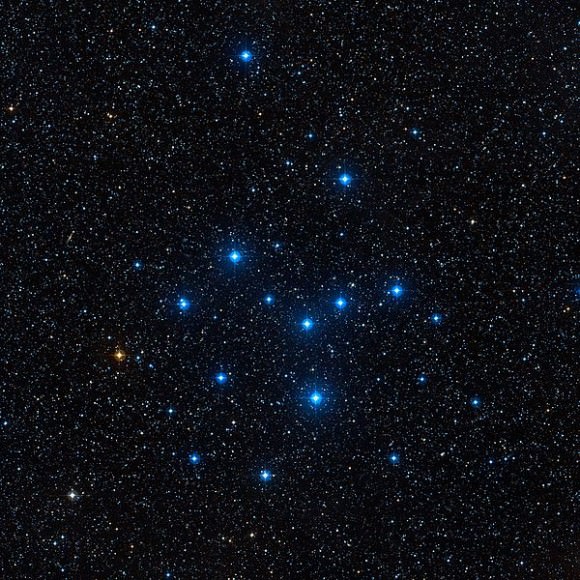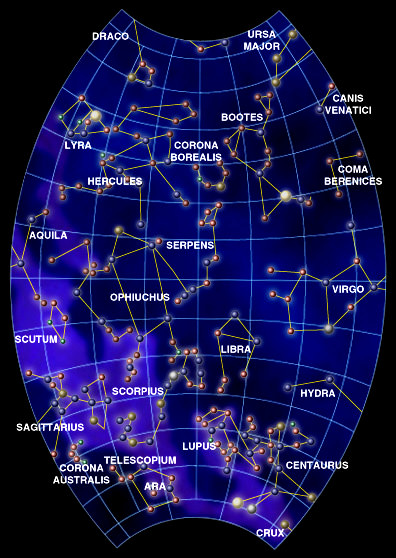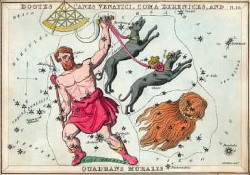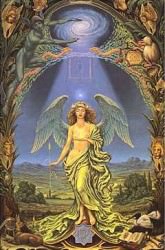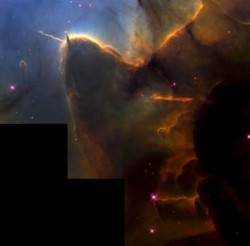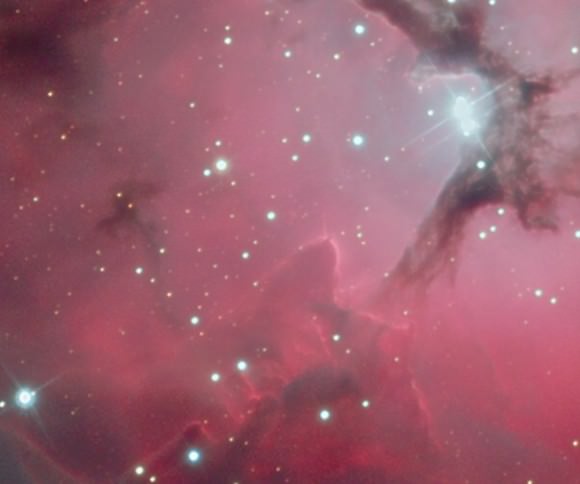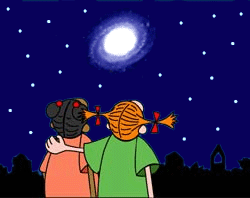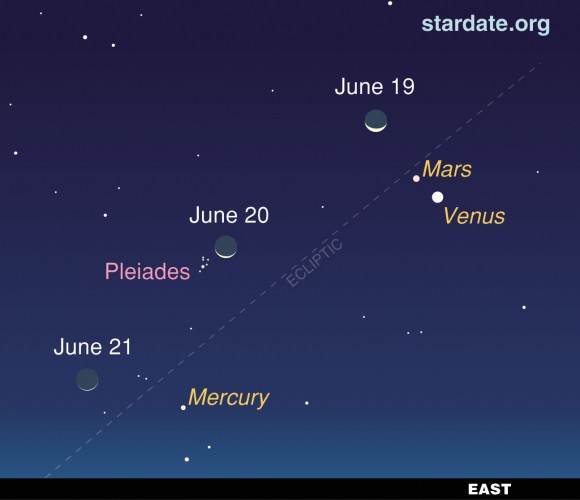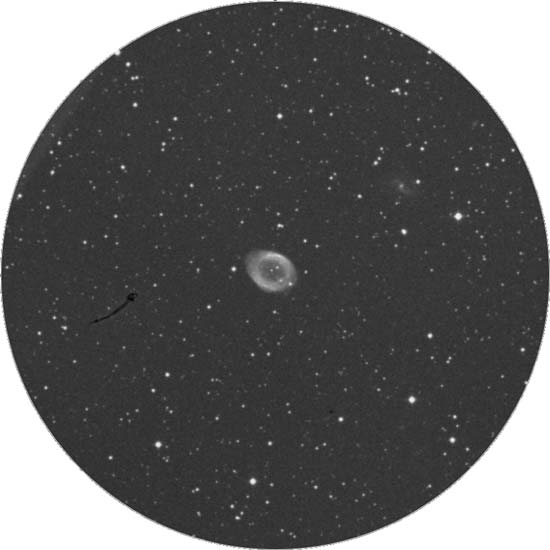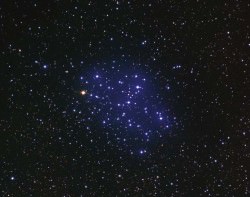Greetings, fellow SkyWatchers! Are you ready for a Moon-filled weekend? Then let’s have a look a some great lunar features as we race Mad Max to the “Megadome”! For some lucky viewers in Japan and Hawaii, there will be an occultation of Antares to enjoy. How about some great double stars… Or a chance to see if you can spot a penumbral lunar eclipse? Then follow me out to the backyard. The stars are waiting…
Friday, July 3, 2009 – Tonight let’s venture toward the south shore of Palus Epidemiarum to have a high-power look at crater Capuanus. Named for Italian astronomer Francesco Capuano di Manfredonia, this 60 kilometer-wide crater boasts a still tall southwest wall, but the northeast one was destroyed by lava flow.
At its highest, it reaches around 1,900 meters above the lunar surface, yet drops to no more than 300 meters at the lowest. Look for several strikes along the crater walls as well as more evidence of a strong geological history. To the north is the Hesiodus Rima, a huge fault line that extends 300 kilometers across the surface!
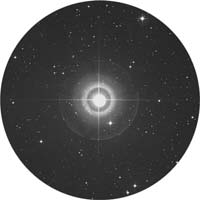 When you’re done, why not have a look at 156-light-year-distant Mu Serpentis (RA 15 49 37 Dec –03 25 48)? Its name is Leiolepis, which means ‘‘smooth scaled.’’ Perhaps a fitting name, because this normal A-type main sequence star is also known as the head of the serpent. Have a look in binoculars, and you’ll note several optical companions. Or use a telescope to locate delicate binary Struve 1985 (RA 15 56 01 Dec –02 11 00) nearby!
When you’re done, why not have a look at 156-light-year-distant Mu Serpentis (RA 15 49 37 Dec –03 25 48)? Its name is Leiolepis, which means ‘‘smooth scaled.’’ Perhaps a fitting name, because this normal A-type main sequence star is also known as the head of the serpent. Have a look in binoculars, and you’ll note several optical companions. Or use a telescope to locate delicate binary Struve 1985 (RA 15 56 01 Dec –02 11 00) nearby!
Saturday, July 4, 2009 – Look closely at the Moon. For some lucky viewers, it’s about to occult Antares! Check International Occultation and Timing Association (IOTA) for times and locations.
Also be sure to look for the ‘‘Cow Jumping over the Moon,’’ but power up with a telescope to study some very wild looking features—lunar lava domes. North of Aristarchus, west of Promontorium Heraclides, and near the terminator is Rumker—the largest of the lava domes. Only visible when near the terminator, this roughly 77-kilometer-diameter ‘‘soft hill’’ ranges anywhere from 60 to 760 meters tall. Although it is not much more than a bump on the lunar surface, it does contain a few summit craters at its highest points. What we are looking at is really an important part of the geology that shaped the Moon’s surface. In all likelihood, Rumker is a shield volcano. . .in an area of many!
Now continue east toward the prominent crater Marian, set in a bright peninsula extending into Sinus Roris and Mare Imbrium. Just southwest are two more—Mons Gruithuisen Gamma (the ‘‘Megadome’’) and Mons Gruithuisen Delta. Although you might not find these features particularly impressive, consider that we’re looking at something only 20 kilometers wide and only a few meters high!
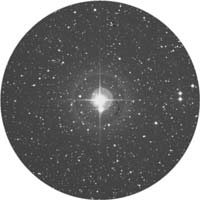 Tonight we honor American astronomer Henrietta Swan Leavitt, the discoverer of the relationship between period and luminosity in Cepheid variables. This led to understanding the distance to the galaxies! Said Leavitt, ‘‘Since the variables are probably nearly the same distance from Earth, their periods are apparently associated with their actual emission of light, as determined by their mass, density, and surface brightness.’’ Do her memory honor and check out Delta Cephei (RA 22 29 10 Dec þ58 24 54) tonight! Thirty to forty times more massive than our own Sun, Delta varies from magnitude 3.6–4.3 in just slightly over 5 days. And look for its companion star as well.
Tonight we honor American astronomer Henrietta Swan Leavitt, the discoverer of the relationship between period and luminosity in Cepheid variables. This led to understanding the distance to the galaxies! Said Leavitt, ‘‘Since the variables are probably nearly the same distance from Earth, their periods are apparently associated with their actual emission of light, as determined by their mass, density, and surface brightness.’’ Do her memory honor and check out Delta Cephei (RA 22 29 10 Dec þ58 24 54) tonight! Thirty to forty times more massive than our own Sun, Delta varies from magnitude 3.6–4.3 in just slightly over 5 days. And look for its companion star as well.
Sunday, July 5, 2009 – Tonight let’s go deep south and have look at an area that once held something almost half a bright as tonight’s Moon and over four times brighter than Venus. Only one thing could light up the skies like that—a supernova.
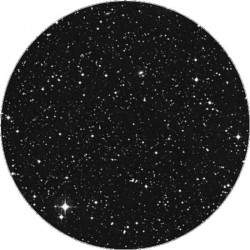 According to historical records from Europe, China, Egypt, Arabia, and Japan, 1,003 years ago the very first supernova event was noted. Appearing in the constellation of Lupus, it was at first believed to be a comet by the Egyptians, yet the Arabs saw it as an illuminating ‘‘star.’’ Located less than a finger-width northeast of Beta Lupi (RA 15 02 48 Dec –41 54 42) and half a degree east of Kappa Centaurus, no visible trace is left of a once-grand event that spanned 5 months of observation, beginning in May and lasting until it dropped below the horizon in September 1006. It is believed that most of the star was converted to energy, and very little mass remains. In the area, a 17th magnitude star that shows a tiny gas ring and radio source 1459-41 remains our best candidate for pinpointing this incredible event.
According to historical records from Europe, China, Egypt, Arabia, and Japan, 1,003 years ago the very first supernova event was noted. Appearing in the constellation of Lupus, it was at first believed to be a comet by the Egyptians, yet the Arabs saw it as an illuminating ‘‘star.’’ Located less than a finger-width northeast of Beta Lupi (RA 15 02 48 Dec –41 54 42) and half a degree east of Kappa Centaurus, no visible trace is left of a once-grand event that spanned 5 months of observation, beginning in May and lasting until it dropped below the horizon in September 1006. It is believed that most of the star was converted to energy, and very little mass remains. In the area, a 17th magnitude star that shows a tiny gas ring and radio source 1459-41 remains our best candidate for pinpointing this incredible event.
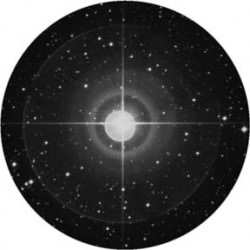 Why you’re at it, try a challenging double star—Upsilon Librae (RA 15 37 01 Dec –28 08 06). This beautiful red star is right at the limit for a small telescope, but quite worthy, as the pair is a widely disparate double. Look for the 11.5-magnitude companion to the south in a very nice field of stars!
Why you’re at it, try a challenging double star—Upsilon Librae (RA 15 37 01 Dec –28 08 06). This beautiful red star is right at the limit for a small telescope, but quite worthy, as the pair is a widely disparate double. Look for the 11.5-magnitude companion to the south in a very nice field of stars!
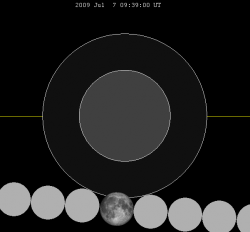 If you’d like to try for a challenging observation, then take look on the universal date of July 7th for a partial penumbral eclipse. While this isn’t anything to get intensely excited over, since the Moon will only graze through a small portion of the Earth’s shadow, chances are you might just notice something a little different. While a certain very reputable periodical says “The moon skims through too little of the penumbra to be noticed even by the most intent observer.” – I have also heard them say things like the partial solar eclipse won’t be visible here or there – and proved them wrong. It’s only my opinion, of course, but I believe no one should be discouraged from making an observation if they have the time, the energy, the location or the desire! So here’s what to do…
If you’d like to try for a challenging observation, then take look on the universal date of July 7th for a partial penumbral eclipse. While this isn’t anything to get intensely excited over, since the Moon will only graze through a small portion of the Earth’s shadow, chances are you might just notice something a little different. While a certain very reputable periodical says “The moon skims through too little of the penumbra to be noticed even by the most intent observer.” – I have also heard them say things like the partial solar eclipse won’t be visible here or there – and proved them wrong. It’s only my opinion, of course, but I believe no one should be discouraged from making an observation if they have the time, the energy, the location or the desire! So here’s what to do…
The partial penumbral eclipse will be seen starting in eastern Australia as the Moon rises just after dusk on July 7th and it will occur as the Moon is setting over western North and South America in the early predawn hours of July 7th. Only the northern third of the lunar surface will be affected, and it will be just a slight change in coloration – a vague gray shadowing. However, this is simply a prediction on the vague part! I have seen times when this happens that the appearance is very noticeable, and times when you truly can’t tell at all. Why not judge for yourself? I look forward to hearing your results!
Good luck and clear skies…
This week’s awesome images are: Capuanus, Marian and the Megadome (credit—Wes Higgins), Mu Serpentis, Delta Cephei, Field of SN 1006 and Upsilon Librae (credit – Palomar Observatory, courtesy of Caltech). We thank you so much!


